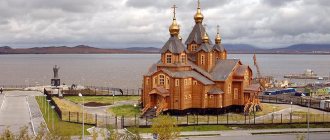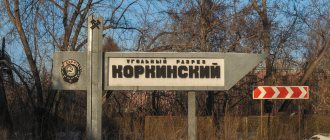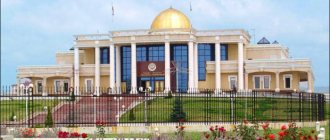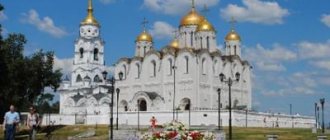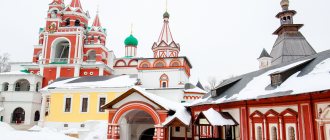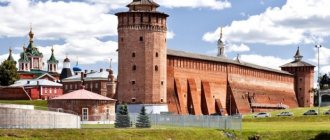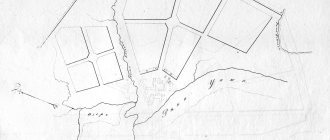Derbent
Regional center in Dagestan, located 121 km southeast of Makhachkala.
General information
Derbent is located on the shores of the Caspian Sea, on the spurs of the Tabasaran Mountains of the Greater Caucasus. The territory of the city encloses a narrow coastal strip known as the Derbent Passage or the Caspian Gate. The city has a seaport, a railway station on the Makhachkala - Baku line, and the M29 highway (Rostov-on-Don - Baku) passes through the city.
Sea port. Railway station on the Makhachkala-Baku line. Located on the highway (Rostov-on-Don - Baku). The population, according to 1992 data, is 82 thousand people (in 1897 - 14.6 thousand; in 1926 - 23.1 thousand, in 1939 - 34 thousand, in 1957 - 47 thousand , in 1979 - 67.4 thousand).
The Caspian Gate has long been known as the only convenient natural route for passage from the steppes of the North Caucasus to Transcaucasia and the Middle East. The strategic importance of this place at the junction of roads running along the sea and leading into the mountains, for many centuries made it the object of the aggressive aspirations of the Scythians, Huns, Khazars, Persians, Arabs and Turks. Derbent (in Persian Dar-band - gate junction) was founded by order of the Iranian king Yazdegerd II from the Sassanid dynasty (reigned 435-457) as a fortified city on the northern border of the Persian possessions. The construction of Derbent negated the significance of the ancient city of Caucasian Albania that existed a little south of it, called Chora or Jora in the Armenian chronicles, and Tzor, Tzur or Tsur in the Byzantine chronicles. The name of the ancient Albanian city in some languages of the Dagestan highlanders was assigned to Derbent. The Laks still call Derbent by the name Churul, and the Dargins - Chulli. The Arabs called Derbent Bab-al-Abwab - the gate of the gate, the Tatar-Mongols and Turks - Temir-Kapi - the iron gate, the Georgians - Dagvis-Kari - the sea gate, the Russians - Derben, or the Iron Gate.
Initially, the walls of Derbent were made of adobe. In 567, during the reign of the Sasanian king Khosrow I Anushirvan, the construction of stone defensive walls began, some of which still border the city from the north and south. Construction was carried out in stages: first the citadel and the northern wall of the city, then the southern wall (both walls were located parallel to each other, in the west they adjoined the citadel, and in the east they went into the sea at a considerable distance from the coast, forming a harbour), later - the Mountain Wall (Dag-bars; to the west of the citadel; had a length of over 40 km) - a complex system of defensive structures designed to prevent the bypass of the fortress along mountain valleys and passes. In the 6th century. The first transverse wall was also built, separating the inhabited part of Derbent near the citadel from the uninhabited coastal part. In the 6th-7th centuries. Derbent is not only an important stronghold in the fight against nomads, but also a significant cultural center of the Caucasus. In the 630s, taking advantage of the weakening of Sasanian Iran due to the war with Byzantium, Derbent was captured by the Khazars. In 652, Arabs appeared at the city walls. With the inclusion of Derbent into the Arab Caliphate, mosques were built in the city (including the cathedral Juma Mosque), most of its residents converted to Islam. In the 8th century. under the commander Maslama ben Abd al-Melik, Derbent became a major military-political center of the Caucasus, in which the residence of the governor of the caliph was located. In the 8th-10th centuries. Derbent is a center of maritime trade, the main port on the Caspian Sea. In the 10th century, with the collapse of the Arab Caliphate, Derbent became the center of an independent emirate. In 1071, the city was captured by the Seljuk Turks. In the 13th century Derbent, conquered by the Mongols, is falling into decay. In the 16th - early 18th centuries. Derbent was part of Persia; at the beginning of the 17th century. The Safavid ruler Shah Abbas made efforts to restore the fortifications and port, turning the city into a Safavid stronghold in the Eastern and Northern Caucasus. In 1722, Derbent was annexed to Russia as a result of the Persian campaign of Peter I (the population of the city, led by the local naib and Muslim clergy, solemnly greeted the Russian emperor). In 1735, according to the Treaty of Ganja, Derbent again ceded to Iran. Since 1743 - the center of the Derbent Khanate, the residence of Nadir Shah. In 1796 it was occupied by Russian troops, and in 1813, according to the Treaty of Gulistan, it was finally annexed to Russia.
According to gen. According to the plan of 1824, active development of the lower, seaside part of the city (Dubary) began: the transverse wall was demolished (in its place a city square was created), regular blocks with straight wide streets were laid out. Since 1840 Derbent has been a district city, since 1846 a provincial city. Since the 1840s was experiencing a rapid economic a rise associated, in particular, with the development of madder farming (growing madder, a plant from which a cheap dye was obtained). In addition to the cultivation and processing of madder and poppy, the occupations of the residents of Derbent in the 19th century. there were gardening, viticulture and fishing. In 1898, the Petrovsk-Port - Baku railway passed through Derbent.
The names of the Decembrist writer A.A. Bestuzhev-Marlinsky (demoted to private, served here in 1830-1834; the house where he lived is preserved in the old part of the city), surgeon I.P. Pirogov (visited Derbent in 1847), French writer A. Dumas the father (he expressed his impressions of Derbent in his travel notes “The Caucasus from Prometheus to Shamil”).
By the beginning of the 90s of the 20th century. in Derbent there was a factory of grinding machines and. Derbent is an ancient center of carpet weaving. The city's wool spinning factories supply wool not only to the local carpet factory, but also to many similar enterprises in the countries of Central Asia and Transcaucasia. The canning plant (produces canned fruit, vegetables, fish and meat) of Derbent is known for the production of high-quality grape wines. The city has a cognac factory, food industry enterprises, and enterprises producing building materials. There is a carpet weaving school in the city.
In Derbent there is the Lezginsky Theater named after. S. Stalsky. At the historical, architectural and art museum-reserve of Derbent there are museums of archeology, culture and life of ancient Derbent, carpet and folk arts of Dagestan, ethnography and life of the peoples of the Caspian region, and Military glory.
On the territory of the citadel, remains of palace complexes of various periods have been identified: near the eastern wall - Albanian times (ancient; small in size, simple configuration, in the masonry - stones decorated with ornamental carvings), Sasanian and Arab times (monumental, complex in layout; Sasanian palace - 6 -7 centuries, about 3000 sq.m.); in the northwestern part, below - pre-Mongol times (2 complexes of large processed stone and baked brick), above - 14-17 centuries. (2 complexes of burnt brick and torn stone); the ruins of the palace buildings of the Derbent Khan (second half of the 18th century), an underground structure “stone bag” (cellar or prison for the Khan’s prisoners), water tanks (early 17th century), baths (rebuilt in the 17th century), guardhouse ( classicism, 1828; rectangular in plan, one-story, with an arcade in front of the main facade), fortress walls of Derbent (shell rock, thickness 2.3-3.8 m, height up to 12-15 m) with towers and gates, in including the Kirkhlyar-Kapy gate in the northern wall (6-13th centuries) and the Orta-Kapy gate in the lower wall (originally - 6th century; rebuilt several times). In the upper, old part of Derbent, adjacent to the citadel, there is a typical Muslim medieval city with a network of narrow crooked streets, onto which open the blind facades of 1-2-story houses, with mosques, water fountains, and baths. In this part of the city there are: the Juma mosque complex, consisting of the mosque itself (8th century), a madrasah (15-19th centuries) and three arched gates (17-19th centuries); Kirkhlyar Mosque (17th century), rectangular in plan, above the central part there is a pointed dome; Minaret-mosque (18th century; partially rebuilt in the 19th century) with the only dilapidated minaret in Derbent (14th century); Chertebe-mosque (18th-19th centuries) with carved wooden parts and a pillar supporting flat ceilings and a gallery. Near the Kirkhlyar cemetery (part of the northern Derbent cemetery) is the former Khan's mausoleum (1787-1788, an octagonal building with a pointed dome); baths, almost 2/3 buried in the ground, covered with vaults and domes (17-18 centuries); underground cisterns (17th - early 19th centuries); remains of a caravanserai (17th-18th centuries). In the lower, new part, regularly laid out, buildings from the 19th - early 20th centuries have been preserved: a railway station (late 19th century), a passage (covered market), an Armenian temple (now the Museum of Fine Arts; 19th century).
In the 20th century Derbent was reconstructed (general plan 1955). Many residential (a microdistrict to the north of the main building with multi-storey buildings) and public buildings (including the Rodina and Yubileiny cinemas) were built.
The city has monuments to: fighters for Soviet power in Dagestan (sculptor G. Geybatov, architect V. Skugarev); S.M. Kirov (1938, architect I. Oleinikov); soldiers who died in the Great Patriotic War of 1941-1945. (1985, S.Ya. Yagudaev, S. Khizgilov).
Sources:
- Cities of Russia: encyclopedia. - M., 1994.
- Derbent is 5000 years old. - M., 1989.
- Markovin V.I. Roads and paths of Dagestan. - M., 1988.
- Kudryavtsev A. A. Ancient Derbent. - M., 1982.
- Khan-Magomedov S.O. Derbent. Mountain wall. Villages of Tabasaran. - M., 1979.
Sights of the “Caucasian Jerusalem”
The main attraction of the city is, of course, its fortress complex. In its current form, the famous Derbent fortress was built in the 6th century by the Persians under Shah Khosrow I. The main task of the fortification was reliable protection from attacks that plagued the city, the Khazars and other nomads from the north. During the construction, the previous structures were used, but the old masonry made of unreliable mud brick was almost everywhere replaced with hewn stone blocks.
The citadel of Derbent Naryn-Kala is located on a hill three kilometers from the seashore. From there, along the entire old city, two walls stretched towards the sea. The distance between them was 300–400 meters from one another. Apparently the northern wall was built slightly earlier than the southern one. In the east, the Derbent Wall extends almost half a kilometer into the sea, reliably locking the city harbor.
It is interesting that previously, from the citadel, many kilometers far into the mountains there were serious fortifications called Dag-Bars, the main duty of which was to protect the territories subject to the city rulers from the raids of nomads. Now only isolated fragments remain of this Great Caucasian Wall, about 42 km long.
The fortified buildings of Derbent were included in the UNESCO World Heritage List in 2003. This complex, an “open-air museum”, including the Naryn-Kala fortress, the double Derbent wall and Dag-Bary, is unique in that it is the largest fortification structure of this type after the Great Wall of China.
Inside the Derbent citadel, a small ancient church of the 5th century was almost miraculously preserved. Subsequently, the temple was rebuilt several times - first by fire-worshipping Persians, and then by Arabs, into a mosque.
In addition to the fortifications, UNESCO also particularly noted the value of the main religious building of old Derbent, the Juma Mosque. Unlike most, both ancient and modern mosques, the entrance to this religious building is located on the southern part of the building, and not the northern.
This is the oldest mosque in the entire territory of Russia, returned to believers during the difficult years of the Great Patriotic War and for a long time remained the only one in the south of Dagestan. It still makes a great impression, but once upon a time, being the tallest building in the city, it probably seemed something incredible.
Of great interest are also the many fortress gates, in varying degrees of preservation. Some of them are located on one of the walls (south or north), others are part of the citadel structures. The importance of the Derbent fortress complex, in addition to its antiquity, also lies in the fact that it is the only structure of ancient Persian military-defensive architecture that has come down to us.
In the historical center of Derbent there are many museums and several ancient mosques. Among the latter, the Kirkhlyar Mosque, the Bala Mosque and the Minaret Mosque are especially interesting. Also not far from these Islamic religious buildings there are Christian – Orthodox and Armenian churches. The Armenian one was built in the middle of the 19th century, the Orthodox one - at the very beginning of the 20th century. A little later, a synagogue was opened in 1914.
The museums located in the city are also very interesting for visitors. These include the citadel itself. The historical, architectural and art museums are also worth a visit. An institution dedicated to the culture and life of the inhabitants of ancient Derbent will tell about life in ancient times.
The Carpet Museum is very unusual and colorful, the exhibition of which is located in the Armenian church. No less interesting to tourists is the “House of Peter I”, the collection of which tells about the Russian emperor and his visit to the fortress.
There are museums in the city dedicated to the nature of the Caspian region, the history of world religions and cultures, and the Decembrist Bestuzhev-Marlinsky. This forgotten Russian writer, exiled first to Yakutia, then to the Caucasus, lived and worked in Derbent.
He left interesting notes about the life and customs of local residents, and good fiction, which, although quickly went out of fashion, had a considerable influence on his contemporaries, including Pushkin and Lermontov.
If you believe the local legend, then Saint George found his last refuge in the vicinity of Derbent. His supposed tomb is located in the village of Upper Dzhalgan. In the village of Nyugdi there is the Church of St. Grigoris. It is believed that this is where St. died. Gregoris of Albania. For Muslims, a sacred place is the Kirkhlyar (Kirkhlyar) cemetery, where 40 martyrs who died in the early Middle Ages in the battle with the Khazars are buried.
There is everything for tourism and recreation here
Today, a modern recreational infrastructure has been created in the city itself and its surroundings. There are hotels, tourist centers, mini-hotels. The sea in Derbent is warm and clean. In general, its depth is relatively small, so it warms up well. But it is on this coast that the Derbent depression begins. Therefore, the sea here is somewhat deeper and much cleaner than in more northern areas of the water area.
The Caspian Sea is also about fish. You should definitely enjoy fish dishes in the local restaurants, as well as dishes of real Caucasian cuisine. And be sure to try the local cognac factory.
A trip to a beautiful old city is an opportunity to look at the unique architecture and enjoy the truly oriental Caucasian flavor. The Caspian Gate has long been at the crossroads. Not only the most important route from north to south passed here, but also the route of the famous Great Silk Road to Europe from China.
The streets of Derbent still retain the charm of the East today. The old part of the city has many interesting buildings built centuries ago. Photos of Derbent represent a bizarre mixture of hoary antiquity and modernity, the enchanting East and the pragmatic West.
You can talk endlessly about the ancient city, its history and attractions, but it’s better to see it with your own eyes! Come on vacation to Dagestan, swim in the Caspian Sea, get acquainted with the life, customs and cuisine of the Caucasians and visit one of the pearls of the North Caucasus - ancient Derbent.
PS From my experience I will say that all my friends from other regions of Russia, who once visited here, simply dream of coming to this eternal city again. Therefore, welcome to ancient Derbent!
